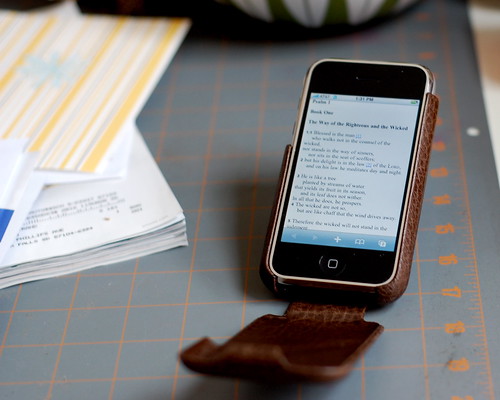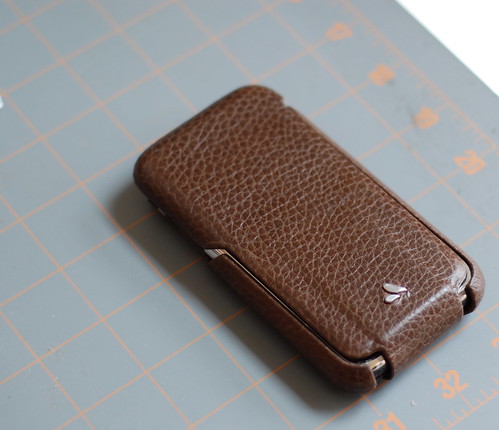The ESV on an Apple iPhone
At the risk of alienating the Luddites in the audience, I've decided to post the answer to a question I often receive, which usually goes something like this: "Mark, with all the cool Bibles reviewed on your site, which one do you actually use the most?" Even though I'm situated in an Aladdin's cave of goatskin, calf, and india paper, the Bible I use most often these days is bound in aluminum and glass. And it's not really a Bible at all. It's a phone. An Apple iPhone, to be precise.
 Above: the iPhone "open" to Psalm 1 in the English Standard Version.
Above: the iPhone "open" to Psalm 1 in the English Standard Version.
If this comes as a surprise, believe me no one is as surprised as I am. When the iPhone came out last summer, I prided myself on not being one of the sheeple who stood in line. (My pride was based on a mere technicality: my father and brother, even greater technophiles than me, stood in line and bought one for me.) After plunging a lot of money into the black hole that was the Pocket PC circa 1999, I had pretty much given up on "convergence," the dream of a single device to rule them all. My judgment was confirmed after I inherited a Motorola SLVR (giving up my perfectly good pre-Sony Ericsson T28) with the idea that it would combine the functions of phone and iPod. It did, but not very well, and I decided the future was still in the, well, future.
Now I'm a believer. The future started last July, but not everyone realizes it yet.
But this isn't about the iPhone. It's about the Bible on the iPhone. At first, I didn't take advantage of the possibilities. I had a bookmark to the ESV Online in my Safari browser, but more often than not I'd forget it was there. Then the ESV Blog posted some (for me) historic news: how to "Add the ESV to your iPhone Home Screen." Specifically, you can create an icon for any of the ESV's many online reading plans and have it display right on the home screen, giving you one-click access to the day's reading. I followed the instructions and that did the trick. Hardly a day goes by now when I don't take advantage of it.
 Above: The icon in the lower right-hand corner brings up the Daily Reading Bible selection in a Safari window.
Above: The icon in the lower right-hand corner brings up the Daily Reading Bible selection in a Safari window.
Technically, the ESV isn't on the iPhone. When you click the icon, you launch a browser window in Safari, which pulls up the same text you'd see if you accessed the page from your home computer. The difference is, you don't carry your home computer everywhere you go. For this to work, of course, you need either a wireless signal (fast) or a phone signal to access AT&T's Edge network (slow, but not as bad as I had feared).

Above: Exodus 14:21-31, today's Old Testament reading from the Book of Common Prayer Lectionary.
The nice thing for aging eyes is that you control the type size. If the standard layout shown above doesn't do it for you, just turn the phone sideways for the landscape view. If that's still not larger enough, you can zoom in closer by making a pinching motion on the touchscreen.

Above: The text displayed in landscape mode -- much easier to read.
As you can see from the photos, I couldn't leave well enough alone in the glass and aluminum department. The problem with most iPhone cases is that they add too much bulk to the device. After much searching, I found this brown leather one made by the well-known Argentine leathergoods company Vaja. It's called the ivolution Top. Yes, it increases the iPhone footprint a bit, but not as much as other cases I've looked at, and the textured leather keeps the phone from slipping out of my hand, something it likes to do at the worst possible moments. Back in the Pocket PC days, I had a Vaja flip-case for my Compaq iPAQ, so this was like coming full circle -- only the sheathed iPhone is about a tenth of the size.

Above: The Vaja ivolution Top case, closed. The flap is secured via friction. It clips over the top of the phone securely, without any snaps or magnets. The docking port is covered, but the speakers, earphone jack, and the various volume buttons are exposed for easy use.
Below: The ivolution Top, with the flap opened. It hangs low enough not to interfere with one-handed use.

When you consider how much I like small Bibles, it's no surprise that the iPhone-as-Bible appeals to me. It's the Bible I carry when I'm not carrying a Bible. Personally, I don't like having a bunch of little devices to carry, so in the past I tended to leave digital cameras, music players, etc., behind. A cell phone is the only pocket device I've had the discipline to carry pretty much always. Because I can now read the Bible on my phone, I almost always have Scripture handy, no matter where I happen to be.
Look at the form factor. With the Vaja case attached, my iPhone measures about 2.5 x 4.5, and just over half an inch thick. One of the smallest Bibles I have is the Cambridge Crystal Reference KJV in goatskin from R. L. Allan's, a beautiful little edition. It measures 3.75 x 5.5, and just under an inch thick. On the ultra-small end of the spectrum, I have a tiny Prayer Book from the 1940s, published by Oxford with a Morocco cover and silk-sewn binding. It measures 3 x 4.5 and just under an inch thick. (There's no way I'd stuff either of these editions into my pocket, but I think this is a worthwhile comparison.)

Above: The iPhone in Vaja case (top), compared to an Oxford BCP (middle), and the Cambridge Crystal KJV from R. L. Allan's (bottom).
Below: The same comparison as seen from above. Note the larger footprint of these pocket-sized books.

The comparison is unfair -- to the iPhone. Since I have it in the Vaja case, it's a bit more substantial than it would be by itself. Stripped down to aluminum and glass, it is very trim indeed.
So does this mean I'm abandoning traditional paper Bibles in favor of vaporware? Hardly. Yes, the ESV on the iPhone is ultra-convenient, and as a result sees a lot of use. But believe me, if you have to choose between reading a full-size edition and the text on a tiny glowing screen, the book is going to win out every time. What I like about the iPhone is having access to the Bible at times I otherwise wouldn't.
Another caveat: I'm one of those people who frowns on using techno-gadgets in church. I tried it once with the Pocket PC and felt like every eye was on me. After two seconds, I had to put the thing away. So I don't really see the iPhone/Bible as a substitute for contexts in which you should have a "real" Bible handy. That's my own bias. You may feel differently.
Let's face it, you're not going to go out and buy an iPhone just to use it as a pocket Bible. But if you happen to have one for other reasons, it's nice to be able to pull up the Bible text with just a touch of the button. One of my goals is to never be without a Bible, something I find a whole lot easier than it was before the iPhone came along.
J. Mark Bertrand is a novelist and pastor whose writing on Bible design has helped spark a publishing revolution. Mark is the author of Rethinking Worldview: Learning to Think, Live, and Speak in This World (Crossway, 2007), as well as the novels Back on Murder, Pattern of Wounds, and Nothing to Hide—described as a “series worth getting attached to” (Christianity Today) by “a major crime fiction talent” (Weekly Standard) in the vein of Michael Connelly, Ian Rankin, and Henning Mankell.
Mark has a BA in English Literature from Union University, an MFA in Creative Writing from the University of Houston, and an M.Div. from Heidelberg Theological Seminary. Through his influential Bible Design Blog, Mark has championed a new generation of readable Bibles. He is a founding member of the steering committee of the Society of Bible Craftsmanship, and chairs the Society’s Award Committee. His work was featured in the November 2021 issue of FaithLife’s Bible Study Magazine.
Mark also serves on the board of Worldview Academy, where he has been a member of the faculty of theology since 2003. Since 2017, he has been an ordained teaching elder in the Presbyterian Church in America. He and his wife Laurie life in Sioux Falls, South Dakota.
